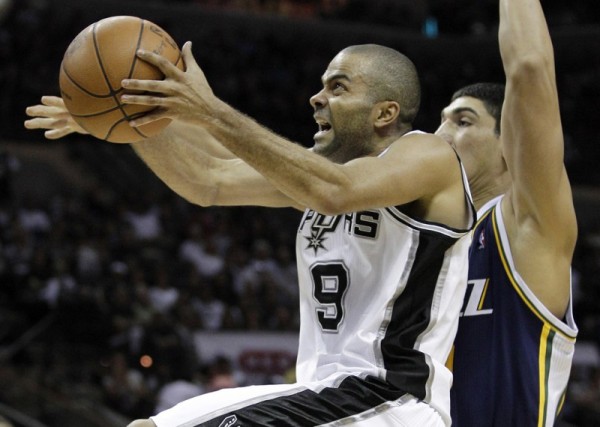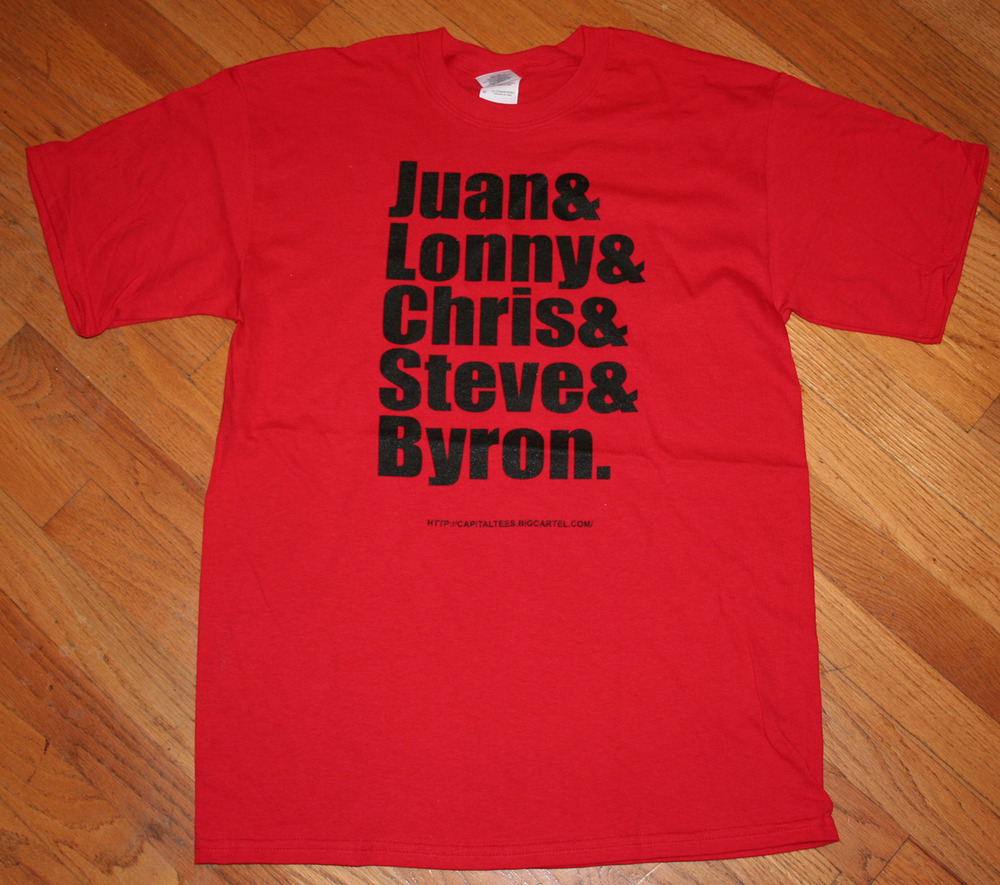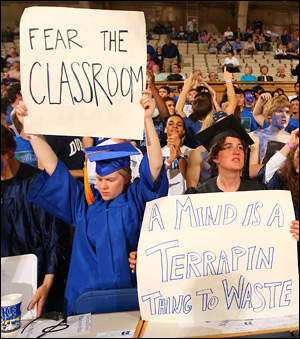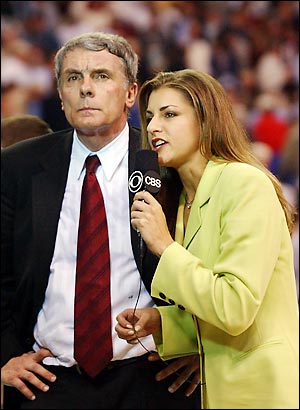Posted by nvr1983 on March 24th, 2008
We found an interesting piece in ESPN.com’s Daily Dime last week. They decided to list players from recent championship teams that are still in the NBA. They happened to miss a few players who we added. We might have missed a player here and there. If we did, leave a comment with an update on their status since it’s hard to keep track of all these leagues around the world.
You may notice that the number of NBA superstars from championship teams has decreased in recent years with the exception of Carmelo Anthony. We feel it is pretty clear that this is becasue a lot of guys who are NBA stars decided to skip college or not stay around long enough to win a title. We’re pretty sure Kobe Bryant, Lebron James, and Dwight Howard (he would be a senior now!) would have affected the NCAA tournament a little.
The list:
2006-07 Florida: Al Horford, Corey Brewer, Joakim Noah, Taurean Green, & Chris Richard.
-All of the UF guys seem like they could end up being solid pros. Even Richard who is spending time in the NBDL could end up being a decent bench guy. Horford has exceeded expectations and is challenging the much more hyped Kevin Durant for Rookie of the Year honors. The real question is whether any of them other than Horford will become stars in the league. Noah and Brewer have a chance, but we aren’t sold on them yet. We think Noah will end up being a solid contributor if he can keep his mouth shut.
2005 North Carolina: Rashad McCants, Raymond Felton, Sean May, & Marvin Williams
– All of the Tar Heels have turned into respectable NBA players, which isn’t surprising to anybody who say this team play. May hasn’t played this year due to injuries, but was putting up respectable numbers when he was healthy. Felton and Williams are definitely the studs of this group although McCants does show flashes of brilliance up in Minnesota not that anybody sees the Timberwolves play.
2004 Connecticut: Emeka Okafor, Ben Gordon, Hilton Armstrong, Josh Boone, & Charlie Villanueva
– While this group has turned out 3 solid NBA players (Okafor, Gordon, and Villanueva), we get the suspicion that none of these guys will turn into the superstars they were expected to be. It seems hard to believe that a lot of people thought Orlando made a mistake drafting Dwight Howard ahead of Okafor in 2004. However, this is a solid group of pros that will probably end up being the equal of the last 2 championship teams (UNC and UF).
2003 Syracuse: Carmelo Anthony & Hakim Warrick
– While Melo has lived up to the hype and is a perennial All-Star, it appears that Warrick is going to stay in the 10 PPG and 5 RPG range, which is probably worth a $8 mill/yr contract or a max contract if Warrick can wait for an offer from Isiah. Having seen this team play at the East Regional in Albany that year, this is one of our favorite championship teams particularly because they were the last team that was a big surprise winning the tournament. We knew that Gerry McNamara’s game wouldn’t work at the NBA level, but we always liked him and often thought that he was closer to Jameer Nelson in college than a lot of analysts were willing to admit.
2002 Maryland: Juan Dixon, Steve Blake, & Chris Wilcox
– The players from this team, which won the ugliest Final 4 in recent memory, have done just about what we expected as pros. Dixon has been a solid player who is often underappreciated by his team and has floated around the league but contributed everywhere he has gone. Steve Blake has provided solid if unspectacular point guard play and won a starting job in Portland for a time over the uber-hyped Sebastian Telfair. Wilcox has been somewhat of a disappointment. He puts up solid numbers, but has never turned into the star that his athletic ability suggests he could be. Of course, he was the same way in college so it shouldn’t come as a surprise.
2001 Duke: Shane Battier, Chris Duhon, Carlos Boozer, & Mike Dunleavy
– It amazing that on this team with several college superstars (including Jason Williams), that Boozer turned out to be the stud of the group. While Casey Sanders’s lack of development forced him to play the center position more than he probably should have, he was a guy who was routinely abused by Brendan Haywood. Somehow, Boozer grew a pair of huevos; so much so that he stabbed a blind man in the back. Just imagine what Boozer could have become if he had stayed in Cleveland to play with Lebron James. Battier, Duhon, and Dunleavy are all solid NBA players even if they haven’t lived up to their draft status (Dunleavy) or hype (Duhon-“What a man!”). To be fair, Battier was selected after Kwame Brown and Eddy Curry, so maybe he wasn’t taken too early. The most disappointing thing about this group is that we never got to see what Jason Williams could have become. Although he struggled adjusting as a rookie with the Bulls, he showed flashes of brilliances including a triple-double against a still-in-his-prime Jason Kidd.
2000 Michigan State: Charlie Bell, Morris Peterson, & Jason Richardson
– Jason Richardson has put up solid numbers even if we have a hard time considering him a star. He’s a phenomenal athlete who has never really made the transition to the superstar (except in fantasy basketball) that many projected for him. Morris Peterson had a solid run as a consistent double-figure guy in Toronto before going to New Orleans this year. As for Bell, we never expected much out of him, but he has had a nice little career and actually averaged 13.5 PPG last year. That championship team’s heart and soul was Mateen Cleaves who had a couple of nice seasons where he was one of the top cheerleaders in the league particularly when he was on the Kings. However, he never stuck and according to Wikipedia he is now playing for the Bakersfield Jam of the NBDL.
1999 Connecticut: Richard Hamilton & Jake Voskuhl
– This team, which we ranked as the best team of the past 10 years, knocked off an unbelievably loaded Duke team that might have been in the top 10 of all-time had they won that night in St. Petersburg. While Hamilton has been an excellent NBA player and one of the few guys in the league who can hit a mid-range jumper, the rest of this team has been a disappointment. We had no idea that Voskuhl was still in the league and barely noticed him when we knew he was in the league. The team’s other star Khalid El-Amin played for a short time in the NBA before finding his way to the CBA and Ukranian Basketball League before end up with Türk Telekom B.K. of the Turkish basketball league. We weren’t able to find much information about Ricky Moore, the star of the title game. We’re assuming that he had a rather undistinguished career after that night in St. Pete.
1998 Kentucky: Nazr Mohammed & Jamaal Magloire
– The Wildcats, who weren’t expected to win the title this year, were fueled by a big comeback against a very young Duke team in the South Regional finals. Looking back at this team’s roster, we couldn’t see anybody else on this team making a big impact in the NBA. Magloire had a run from 2002-2006 where he averaged around 10/10 and made an All-Star team (more the result of the lack of centers than his exceptional play) while Mohammed has had a slightly less distinguished career. His most notable achievement was helping the San Antonio Spurs win the 2005 NBA Championship (with an assist from Isiah Thomas).
1997 Arizona: Mike Bibby & Jason Terry
– Both Bibby and Terry have had excellent careers as was expected for them coming out of college. The more intereresting story is that of the team’s star Miles Simon. Simon was never considered a top NBA prospect, but we at least expected that he would stick around the league because he could make plays. Instead he spent a year in Orlando then traveled across the globe, before ending up in the CBA where as his Wikipedia page states he became “the most decorated player in CBA history”. Not exactly what we expect out of the MOP.
1996 Kentucky: Antoine Walker, Derek Anderson & Nazr Mohammed
– This was likely the last of the all-time great teams. This team was incredibly deep with 6 guys who had significant NBA careers (including Tony Delk, Ron Mercer, and Walter McCarty). This team just crushed the teams they played utilizing Pitino’s press with their superior talent and athleticism. None of the players ever became a superstar, but all of their studs had solid NBA careers including a handful of All-Star appearances and awards. We’ll leave Rick Pitino’s stint in Boston for another post.
1995 UCLA: N/A
– This team didn’t really have as many superstars as other championship teams did, but they played very well together finishing an impressive 32-1. They had 2 first-round picks (Ed O’Bannon and George Zidek) who had short-lived NBA careers. The team’s other stars were Tyus Edney, Toby Bailey, and Charles O’Bannon, but none of them ever did anything notable in the NBA.
1994 Arkansas: N/A
– Nolan Richardson’s “40 Minutes of Hell” team used a late Scotty Thurman rainbow 3 to knock off Grant Hill’s Duke team, which basically consisted of Hill and a bunch of nobodies. Corliss “Big Nasty” Williamson had a nice career first in Sacramento then in Detroit even winning the NBA Sixth Man of the Year in 2002. Thurman ended up leaving school early, going undrafted, and playing in the CBA.
1993 UNC: N/A
– This team didn’t really have any guys we considered potential NBA All-Stars back in 1993. Of course, we were 10 at the time and were already learning to hate the Tar Heels. We’ll let you look at the starting lineup and make up your mind: Eric Montross, Brian Reese, George Lynch, Donald Williams, and Derrick Phelps. Not exactly a murderer’s row of talent there. To be fair, Montross, who hails from the same high school as Greg Oden and Mike Conley Jr. (Lawrence North in Indianapolis), was selected 9th overall by the Celtics and had a decent rookie season before falling off the map. George Lynch was also considered a solid prospect coming out as 12th overall to the Lakers. He only had a mediocre pro career never averaging over 8.6 PPG and his main NBA achievements on Wikipedia are wearing 3 numbers (#24, #30 and #9) while with the Lakers and being traded to the Grizzlies to clear up cap space (and buffet space) for some guy named Shaq. Phelps played briefly in the NBA. And when we say briefly we mean 3 games and 1 shot, which he missed. Donald Williams, who is best remembered for being the MOP and having a huge game against the Fab 5 in the title game, spent his professional career floating around every league on the planet except for the NBA. The more interesting thing is that the Tar Heels actually had more talent the next year when they added Jerry Stackhouse and a young Rasheed Wallace (who in a sign of things to come got tossed from the McDonald’s All-American game) to this nucleus. However, the 1994 team never really came together and lost to Bill Curley and the Boston College Eagles, which was famously captured on this SI cover.
1991-92 Duke: Grant Hill
– Along with the 1996 UK team, Christian Laettner’s Blue Devils were the last of the teams that we consider truly great. To consider how big/great this team was, you have to remember that before this team, Mike Krzyzewski’s boys were the lovable losers who couldn’t win the big one despite multiple Final 4 trips. After this team, Duke became Duke. This team was really built around their 3 superstars: Laettner, Bobby Hurley, and Grant Hill. Everyone knows their college accomplishments: Laettner (#12 on ESPN’s list; maybe the top college player since 1990); Hurley (NCAA all-time assist leader); and Hill (also led Duke to the title game with a YMCA team around him in 1994). Laettner actually had a decent pro career, which most people would realize if he hadn’t been so great in college or if he wasn’t the most hated college player of all-time (multiply Joakim Noah by 100 and you get Laettner). His career highlights include an All-Star appearance as well as being an original Dream Teamer (ok, I can’t type that with a straight face). Hurley was selected 7th overall by Sacramento, but had his career derailed early with a car accident (signs of things to come for another great Duke point guard). However, we don’t think he would have ever become a great NBA PG as evident by how Jason Kidd destroyed him in the 1993 NCAA tournament. Hill actually had the best NBA career of the bunch and was considered one of the top 5-10 players in the league before multiple foot/ankle injuries eventually turned him into a shell of the player that he once was. Antonio Lang was taken 29th overall by Phoenix, but never did much in the pros. Brian Davis played a season in the NBA before floating around the basketball planet and settling on running a Duke-based group that tried to buy the Memphis Grizzlies with Laettner (the deal fell through). Thomas Hill (best known for being the guy crying after Laettner’s 1992 East Regional shot) was drafted 39th overall by Indiana, but never played in the NBA as he played in the Australian National Basketball League for a few years.
That’s all I have on these guys/teams. If you have any more information or comments, feel free to leave them in the comment section.
| rtc analysis
| Tagged: al horford, antoine walker, antonio lang, arizona, arkansas, ben gordon, bill curley, bobby hurley, boston college, brendan haywood, brian davis, brian reese, carlos boozer, carmelo anthony, casey sanders, charles o'bannon, charlie bell, charlie villanueva, chris duhon, chris richard, chris wilcox, connecticut, corey brewer, corliss williamson, derek anderson, derrick phelps, donald williams, duke, dwight howard, ed o'bannon, eddy curry, emeka okafor, eric montross, florida, george lynch, george zidek, gerry mcnamara, grant hill, greg oden, hakim warrick, hilton armstrong, isiah thomas, jake voskhul, jamaal magloire, jameer nelson, jason kidd, jason richardson, jason terry, jason williams, jerry stackhouse, joakim noah, josh boone, juan dixon, kentucky, khalid el-amin, kobe bryant, kwame brown, lebron james, marvin williams, maryland, mateen cleaves, michigan state, mike bibby, mike conley jr, mike dunleavy, mike krzyzewski, miles simon, morris peterson, nazr mohammed, nolan richardson, north carolina, rashad mccants, rasheed wallace, raymond felton, richard hamilton, ricky moore, scotty thurman, sean may, sebastian telfair, shane battier, steve blake, steve lavin, syracuse, taurean green, thomas hill, toby bailey, tony delk, tyus edney, ucla, walter mccarty, where are they now?
Share this story














































